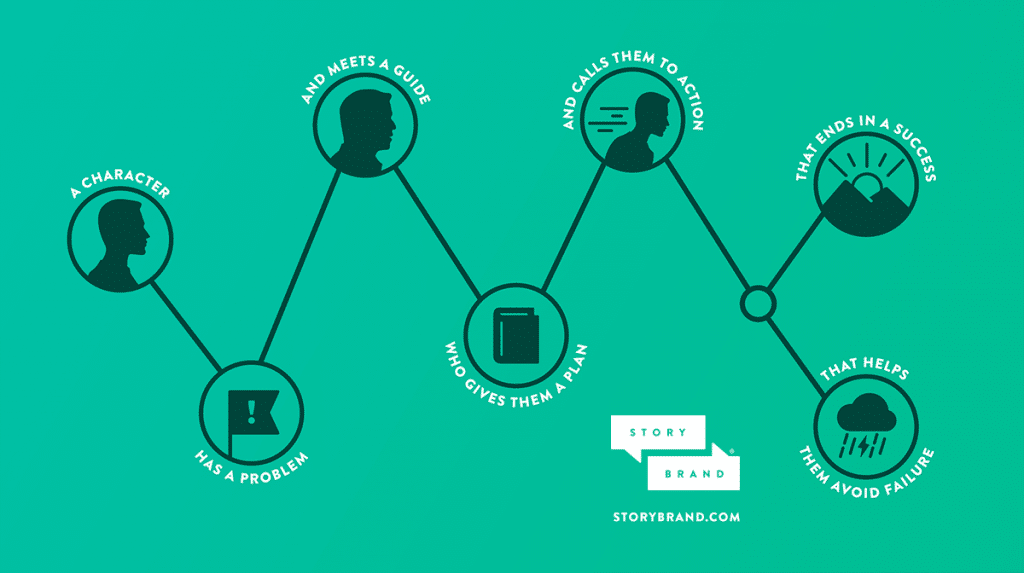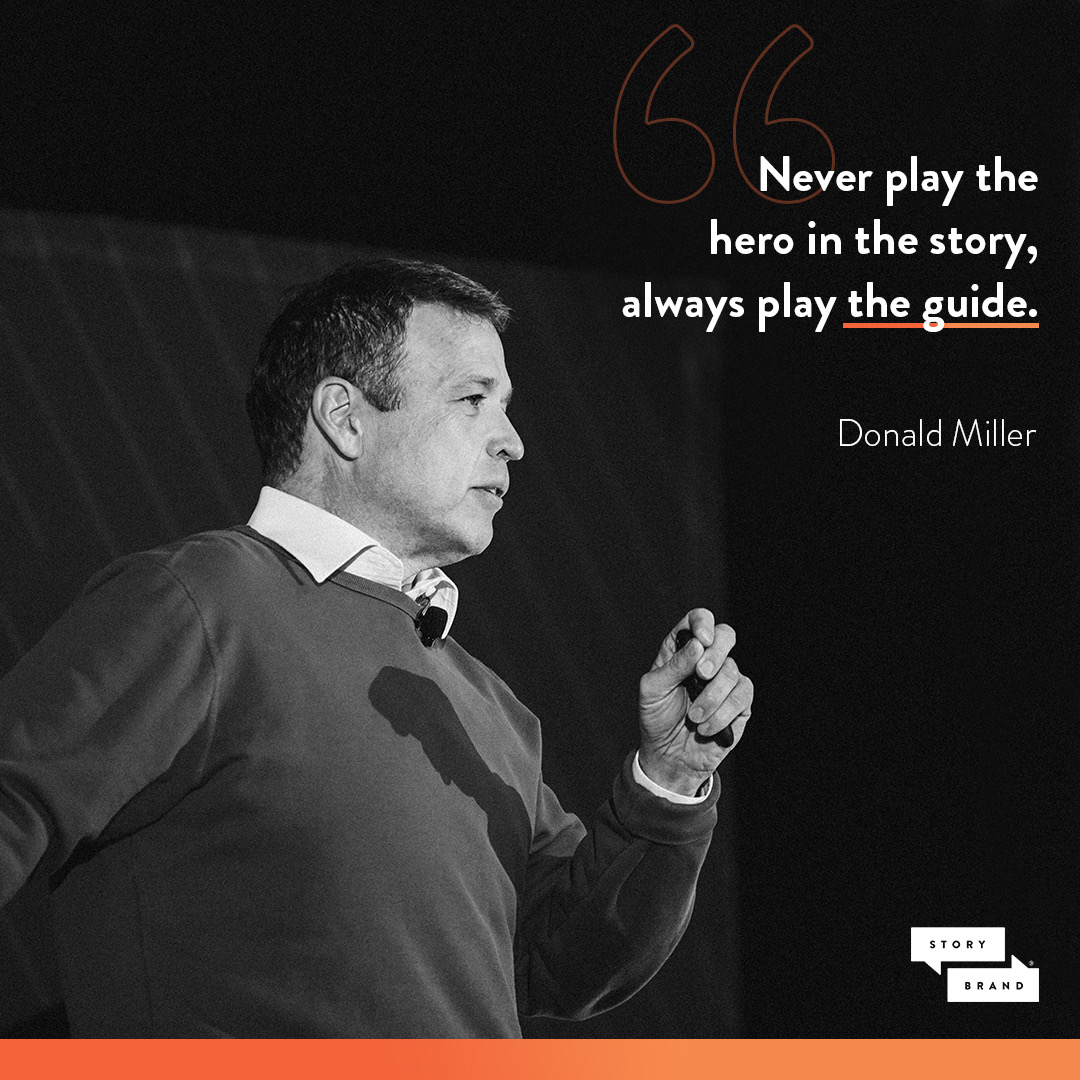Welcome back to Iconic Digital’s SparkNotes series, where we do the reading for you. This week we’re tackling Donald Miller’s Building a StoryBrand: Clarify Your Message So Customers Will Listen. For context (and a bit of a warning), this book is basically Iconic Digital Agency’s Bible. The author, Donald Miller, does not walk on water, but we’re pretty sure he can make money out of old ham bones. So if we seem extra excited as we talk about the ideas in this book, it’s because we believe in them so thoroughly.
Building a Story Brand is not just one of our favorites, though. It’s an important book for anyone with a business or organization that needs to market itself to the public. Everyone knows that “building a brand” is critical to surviving in the business world (see our blog on branding if the concept is newer to you). However, what many people fail to understand is how, exactly, brands are built. Miller’s book fills in this critical gap in understanding by introducing the idea that branding is simply very good storytelling.
Here are some key takeaways from Building a StoryBrand that we find essential to our work, and we think will help you on the path to writing your own brand’s story.
1. The customer is the hero of the story your brand tells.
In every good story, Miller explains, there is a hero who has a problem. The hero meets a guide who gives the hero the tools and advice (a plan) for solving the problem. The hero faces their problems using their newly acquired plan, and is either victorious or not. Miller cites examples of stories from Star Wars to The Hunger Games to Moneyball, explaining that each of these stories follows the same formula. Building a StoryBrand explains how this formula applies to brand creation.

Here’s how Miller’s ‘hero’s journey’ works as a way of communicating with customers: first, the customer is positioned as the hero. They have a problem. Let’s say, their problem is, the outside of their house is looking shabby–just really dirty and gross. And let’s push it a bit further, because, as Miller puts it, “Companies tend to sell solutions to external problems, but people buy solutions to internal problems.” The customer-hero’s external villain is their dirty house, but the internal villain is the embarrassment they feel about having a dirty house. Along comes the guide, YOU, the business or organization with the tools and advice to deal with the problem. You roll in like Yoda, or Haymitch, or Pete Brand, and you say, “I see you have a gross house. I see this is embarrassing to you. I happen to have a plan for solving this problem, because I’ve been there, and I can help you.” You make it clear that if they use your plan, they will have success. They will overcome their problem and live happily ever after. If they choose not to, the consequence may be defeat.

When we start thinking about marketing from Miller’s storytelling perspective, it begins to make sense why certain things don’t work. Miller warns against the pitfalls of positioning yourself as the hero. It’s an easy thing to do, considering that…well, you are the hero of your own life. You have a wonderful product or service, a business or organization you love and you’ve worked hard to create and nurture, and you are interested in seeing it succeed. But your would-be customers are not interested in whether or not you succeed, because they are too caught up in their own heroic journey and solving their own problems. Even if you can solve their problems, if you lead the conversation by talking about your business, your journey, and how awesome you are, the customer will simply stop listening.
In Building a StoryBrand, Miller encourages businesses to think about the following as they approach their marketing:
- Define what the hero (your customer) wants
- Define what their problem is
- Call the hero to action
- Help them avoid failure (by identifying what that failure looks like)
- Help them achieve success (by showing how the brand can transform them)
2. Your brain is not interested in products or services–it’s interested in survival.
In Building a StoryBrand, Donald Miller explains that the human brain’s number one job is to keep us alive and thriving. It is constantly seeking information that will help solve problems that would prevent us from continuing to live and have offspring. But because your brain requires a lot of energy (calories) in order to process information, it has to be selective about the messages it processes. If it burns up all your food trying to make sense of the world, that’s not good for survival. So the brain only pays attention to messages that hold key information that will allow us to survive--that is, information that helps us solve our problems.
This is why the structure of a story works well for pretty much any kind of marketing asset you could imagine–we start with the hero’s problem and propose the solution quickly. This way of organizing information allows human brains to quickly determine whether or not the information is something that will help them survive. If we show customers quickly that we can solve their problems, they are more likely to engage with the rest of the site and learn about the offering.
We all know that food, clothing, shelter and safety are our most basic survival needs. But for modern humans, the survival instinct can manifest itself in less straightforward ways. Miller gives the following examples of ways that humans seek to survive in developed modern societies, where money and social standing give us access to the resources we need:
- Conserve financial resources
- Conserve time
- Build social networks
- Gain status
- Accumulate resources
- Be in a position to be generous
As businesses and organizations, Miller says it’s crucial to quickly show potential customers that we can solve problems that threaten their survival and achieve the goals above.
3. If you confuse, you lose.
It should go without saying that you shouldn’t confuse customers, and yet that’s exactly what so many brands do.

Miller stresses how short of a period of time you have to get a customer’s attention, and insists that effective messages are, above all, memorable. A website, for example, should pass what he calls the “grunt test.” That is, a caveman should be able to read your masthead and grunt out who you are, what you offer, and how they can get it.
The “how you can get it” part is important. Miller advocates for clear, plentiful calls-to-action, so your customers have no doubt that you are offering something, and know how to get it. Miller says, ”People are drawn to clarity and away from confusion. Having clear calls to action means customers aren’t confused about the actions they need to take to do business with you.”
Another great tool to avoid confusion is the development of a One-Liner. The One-Liner is really similar to what should be in your website header, and should identify the customer’s problem, what your product is, and how the product will solve the customer’s problem (the results). It should be easy to memorize and repeat and should go on all your marketing assets. The idea is that in order to get customers to do business with you, they have to remember you, and people remember the messages that are the simplest.
So, in order to avoid confusion, Miller suggests:
- A website header that passes the “grunt test”
- Clear calls to action
- A memorable One-Liner
4. People want your brand to help them transform
Customers are less interested in the products and services they buy, and more interested in the self that those products and services help them become. This shift in thinking about customer need is crucial to getting through to them in our marketing, according to Miller.

“Brands that realize their customers are human, filled with emotion, driven to transform, and in need of help truly do more than sell products; they change people,” Miller says. When you position yourself as a guide, you offer your customers an “aspirational identity”-that is, you show them who your product or service can help them become. They are, after all, the hero.
Miller suggests that smart brands consider:
- How their customers wish to be described by others
- Identify your customer’s identity transformation (for example, with your kickboxing class, the customer will go from passive couch potato to chiseled warrior)
5. Creating a marketing roadmap
Finally Miller suggests following what he calls a “marketing roadmap”–five surefire things to do to grow your business. They are:
- Create a One-Liner (a single statement to memorize and put on all your materials that tells customers everything they need to know to do business with you)
- Create a lead generator and collect email addresses
- Create an automated email drip campaign
- Collect and tell stories of transformation
- Create a system that generates referrals
We can attest to Miller’s promise that enacting this plan will cause your business to grow. We’ve seen it happen over and over. If you’d like to know more about what each of these steps entails, you can download our free guide, Improve Your Marketing Results With Five Simple Steps.
In Building a StoryBrand, Donald Miller shares an equation for good marketing that leverages what we know about the way our brains process information. At the end of the day, we like Miller’s framework, not only because we’ve seen how effective it can be, but because it’s such a humane approach that really takes into account who your customers are as people (and who your employees are as people–turns out good branding has a positive impact on your team as well as your customers!). Miller says “Playing guide is more than just a marketing strategy; it’s a position of the heart.” If you really set the customer up as the hero when you plan your brand strategy, then you are invested in their transformation and want them to succeed. Their success is yours, which is the exact kind of relationship that builds brand loyalty and trust and all the things that people in business wax on and on about when they talk about the value of a brand.
If you find you’re as smitten with StoryBrand principles as we are, and want to dive right in and see the results of brand storytelling right away, we’d love to help. Or maybe you like the ideas and know you want to use it to gain more customers, but you’re still not sure how to start? No problem. We have a StoryBrand Certified Guide at Iconic that can explain it all and help you get things rolling. Let us know what your goals are for your business and we can craft the perfect story for your brand
Be Well,
B. Iconic
PS- If you find yourself hungry for more StoryBrand lessons (we were), you can register for their upcoming workshop here.
